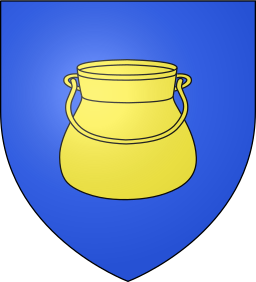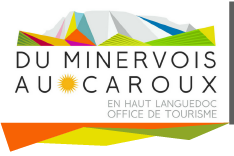![]()
Overlooking the east-west axis of the Orb-Jaur valley, Olargues might be described as a 12th century 'new town'.
The valley has been inhabited since prehistoric times and the neolithic settlers have left a number of traces of their presence in the area: dolmens, menhirs, menhir-statues and the middle Bronze Age 'Peyro Escrito' (inscribed stone) of Olargues.
The Ligurians settled first in this valley around 1000 BC, followed by the Iberians, and subsequently the Volcae Tectosages: Celts from the Baltic Sea.
Then came the Romans who in 118 BC founded Narbonne as their provincial capital.
With the demise of the Roman empire, new invaders arrived in Roman Gaul : the Franks up in the North, and the Goths here in the South who remained in this area, known as Septimania, right up to the constitution of the Holy Roman Empire by Charlemagne. It was they whom he entrusted with the defence of the South against the Moorish and Arab invaders.
With the division of the Empire between Charlemagne's sons and its subsequent fragmentation due both to their fratricidal warfare and to Viking raids across the whole of Europe including the Mediterranean, came the dawn of our village history.
In those turbulent times, the populace congregated around those who could provide protection: the nobility or the church. In exchange they offered themselves as a workforce. Such a movement gave birth both to the village and to feudalism as social structures.
By the 12th century, as life became more stable, communities sought opportunities for successful expansion: the choice of Olargues combined secure defence with a viable economic existence (bounded on three sides by natural defences, with a sufficiently gentle southern slope for implanting a village, plus a water source and land suitable for cultivation and situated at a junction of important routes). We know that in 1127 the ruling family in Olargues, related to the viscounts of Minerve, settled on this outcrop looped by the river Jaur, and it is still possible to see evidence of a first group of houses just below the castle, in the form of hollowed out dwellings, narrow streets, little squares and staircases carved out of the rock. A higher rampart, still well-preserved, protects the castle, while a lower rampart, along which runs a parapet walk, encloses the foundations of huts and meets up with the adjoining façades of buildings closing off the village.
![]()
In the space of a century the barons of Olargues were to build their fortified town with, at the very top, a castle, and a church dedicated to St. Lawrence and consecrated in 1227.
The castle perimeter encloses almost a hectare (10 000 m²) at the top of the village, and recent archaeological excavations have revealed the principles on which the construction of the village was based.
The exceptional technical accomplishment of the Devil's Bridge, a costly and prestigious project which created an essential link with the Nîmes-Toulouse highway, harmonises perfectly with the interleaving contours of the surrounding hills. The lordship of Olargues passed from the viscounts of Minerve to the Anduze clan, and thence to the Caylus and Castelnau de Guers, descending finally to the Thésans, a noble family who brought the village under its authority in the 17th century after a long period during which control was left principally in the hands of consuls elected by the populace.
The scale and survival of the original church (from 1227 until at least 1667) are a clear indication of the supremacy of the ruling nobility and the effectiveness of its alliances. Evidence of these emerges too in the choice and geographical exploitation of the site for the village, and the exceptionally fine architecture of its bridge. The church manifestly supplanted the priory at St Julien to become the parish church. The decision to build a replacement church for the village came only at the very end of the 17th century once the castle had finally been abandoned and had fallen into ruins. The castle served for the next three centuries as a quarry supplying building stone for new construction further down the hill.
Jean-Claude Branville
(Adapted from documents written by the historian Florence Journot and from excavation reports compiled by the archaeologist Astrid Huser)




